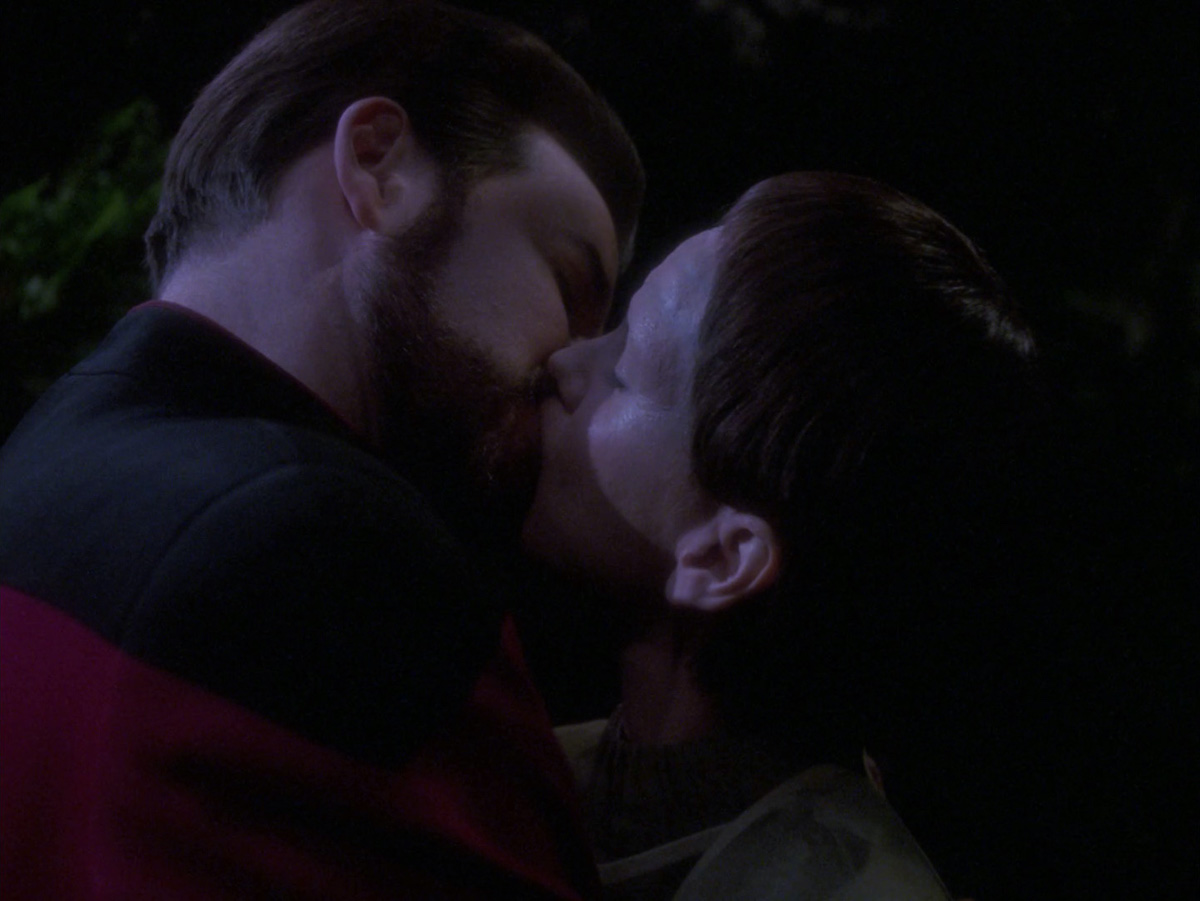“For humans, the sexual act brings a closeness, an intimacy. It can be a very pleasurable experience. Inseminating a husk…”
“The Outcast” is Star Trek: The Next Generation’s LGBTQ episode, and it has aged well by aging badly, if you will. People hate this episode. It is very dated in its conception of the gay struggle; but then, it also earmarks such a specific time and place in the evolution of that struggle that it remains a memorable piece of television. It achieves very little, and makes a few serious mistakes. But Jeri Taylor writes, all in a row, four exceptionally great dialogue scenes between Soren and Riker, and they carry the balance of the episode for me. The rest is historical window-dressing.
It’s a clever enough idea: an asexual species, called the J’naii, where the “queer” culture is therefore made up of anyone who identifies as heterosexual. That’s a home run in the Star Trek methodology of creating an allegory for a current social issue, flipping the real-world idea on its axis to show up its inherent foolishness. Of course, the concept of the J’naii raises all kinds of ancillary questions that the episode has no ability to resolve. It never addresses why an asexual species would still default to a two-person relationship as the normal, given that there’s no sexual basis for the pairing; it can’t explain what would be visibly different between a “normal” J’naii couple and a queer one; and above all, it doesn’t address why sexual species are proliferate throughout the galaxy, while the J’naii are apparently quite unusual. In other words, it’s cis-biased as hell, probably without even knowing how completely it is underscoring the “normalcy” of heterosexual relationships while claiming to attack the bigotry against queer culture.
The real bench strength in “The Outcast” are the four scenes in which Soren and Riker casually explore, and then more and more intimately discuss, the concept of sexual and asexual relationships, as seen from each of their species’ vantage points. It’s didactic, but it’s nicely performed by guest star Melinda Culea against Jonathan Frakes, who underplays Riker so smartly here that one wishes he were bringing this sensitivity to every episode. (The scenes work, largely, because Riker works so well – not a hint of his usual lothario side, but rather an honestly inquisitive man with a healthy relationship with sex. It’s more in line with what Roddenberry thought human sexuality would be like in the future.)
When Soren ultimately reveals that she self-identifies as female and is under constant threat of ostracism as a result, the allegory seems heavy-handed, which happens whenever Next Gen tries for a capital-M Message show. Nonetheless, I admire both of the lead performances. They’re far more deft than they’re given credit for.
The larger J’naii society is of course needlessly contrived in its treatment of Soren and other queers; fortunately, Megan Cole – who plays the J’naii leader – is such a badass actress in general that she manages to bring actual earnest intent to what would other be a transparently one-dimensional role. I do wonder, of course, how one casts an episode such as this. Can a casting agent really send out an audition call for “women who can easily pass for men?”
On that note, Frakes is on the record saying he was disappointed that Soren was not portrayed as more masculine, because that would have been something. It’s hard to escape the essential wussing-out of “The Outcast,” even while admiring what it’s trying to do; if the producers really wanted to make a Star Trek-level dent in contemporary cultural mores, à la Uhura and Kirk’s first interracial kiss on the original series, they should have cast Soren as male.
But then, even Star Trek’s big moments are never quite as big as we remember. That kiss between Uhura and Kirk only got on television because both characters were being manipulated by omnipotent beings, suggesting that a white man and a black woman would never kiss under normal circumstances. The lesbian kiss on Deep Space Nine was actually two heterosexual characters making out, who just happened to be inhabiting like-gendered bodies at the time. Star Trek, to its credit or detriment, always provides a back door for its conservative audience members. Here, within the allegorical cloak that “The Outcast” is trying to weave, we have a relatively stable metaphor for a queer identity; and our most heterosexual character interacting with, and standing up for, that queer identity. But then we also have a good old-fashioned boy/girl romance starring Riker.
This is some problematic shit. I’m still giving it three Enterprises out of five, for effort, performance, and a good idea.

Blogging The Next Generation runs every Tuesday as I work my way through the episodes of Star Trek: The Next Generation on blu-ray. Season Five is in stores now.
